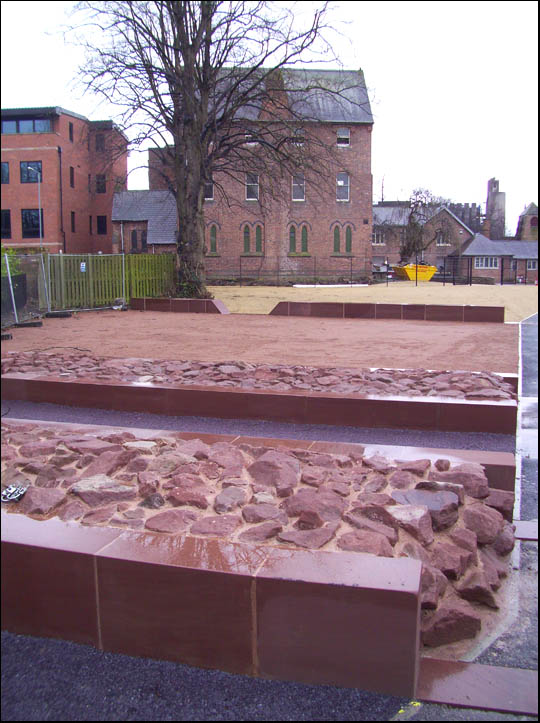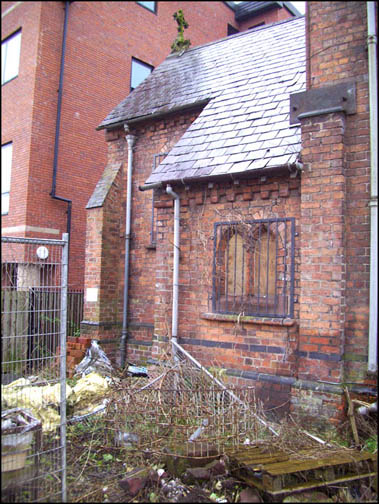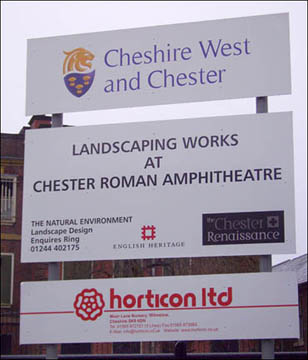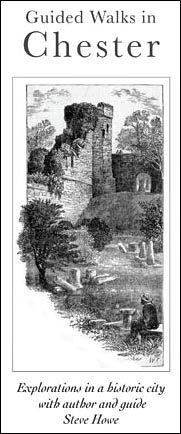|
The Amphitheatre XI |
A Virtual Stroll Around the Walls of Chester The Amphitheatre part XII |
Back to parts 1 | 01 | II | III | IV | V | VI | VII | VIII | IX | X | XI | XIII On to Gallery | Gallery 2 | Gallery 3
The 'opening up' duly happened, resulting in a cheerless, sand-covered expanse populated by the occasional uncomfortable picnic table. But then came the brilliant idea to build a completely new set of 'ancient ruins'- walls and the lines of seating banks- on top of the genuine articles lying beneath! Those behind the proposals, Cheshire West & Chester Council, English Heritage and the tiresomely-inevitable Chester Renaissance, "did not believe the construction of the walls would be controversial as its design would be as historically accurate as possible and in keeping with the records of English Heritage".... In March 2010, the press told us that "visitors to Chester are invited to watch an artist-in-residence create a mural on the back wall of the amphitheatre. Chester Renaissance hope that the 3D mural will give the illusion of a complete circular structure," (there being precious little chance of ever seeing the real thing) "bringing the arena to life"... We recall the idea of a mural on this wall was proposed many years ago by the Chester artist Gregory MacMillan, who, among much else, created the splendid mural in the Roman gravestones gallery at the Grosvenor Museum. His sketches appeared in the local press and the idea received a great deal of support but money and vision were, sadly, in short supply. However, this time around they've got a Londoner in (naturally), one Gary Drostle, who will working over an eight-week period in the Summer. A Chester Renaissance spokesman said of the plans, "the works will enable the amphitheatre to be brought back to life as an open air venue for concerts and theatrical performances, as well as a much-improved tourist destination". Here we present a few photographs of the Chester amphitheatre as it appeared in late April 2010, the programme of 'improvements' nearing completion... |

| The first of four views of the brand spanking new "ancient monument". Here we are in the previously-inaccessable southern half of the site, looking west towards Dee House (centre) and the County Courthouse (far left). The re-opened central walkway can just be seen on the right hand side. Amazingly, the still-unseen entire southern half of the genuine Roman amphitheatre lies beneath this rather cheerless expanse, containing as it presently does nothing but some brand new ersatz ruins and a great deal of sand. We're informed that it will be designated as a family picnic area. |
| Looking west, here we see the brand new walls marking the outer walls of the first and larger second amphitheatres and their supporting buttresses. On the far left, the lines of the seating banks have been laid out with lengths of timber set in sand. |
Here it can be seen that the eastern section of the excavated half of the monument remains lying under its grassy bank, in front of which is the genuine arena inner wall. The infill stones used in the reconstructed 'ruins' in the foreground were taken from a Roman quarry which was discovered when the Delamere Street bus station was demolished a few years ago. |
The new walkway, which pays scant respect to the amphitheatre's main entrance, through which gladiators once strode into the arena...
 |
Of course, the positive impact of the shiny-new amphitheatre upon our visitors may be somewhat tainted by the looming presence of the rotting hulk of Dee House and the artless County Court building behind it. What next for these buildings? 21/7/10: One of our readers recently wrote to the council to ask about the future of Dee House. He received the following brief reply, which he forwarded to us and we now reproduce for your enlightenment: |
This material was apparently expanded into a TV programme that was aired on The History Channel during July 2010. There are, of course, numerous problems with the above, not least the twice-stated statement regarding the "newly discovered" Chester amphitheatre- which actually occured in 1929, as you'll know if you've followed our brief history of the monument. Just one more example concerns that 'shrine'- actually altar- within the amphitheatre, which, as is known to everyone that has visited it, is dedicated to Nemesis, patron goddess of amphitheatres and goddess of retribution, and was placed there by the Centurion Sextus Marcianus "after a vision". It has nothing at all to do with 6th Century martys. You can see a picture of it and learn more on the first page of our story of the amphitheatre. But it is worth mentioning that a fascinating and convincing body of evidence was propounded by Robert Stoker in his book The Legacy of Arthur's Chester (1965) which points out that there were two towns bearing the name of Caerleon (see the 16th century Chester monk Henry Bradshaw's poem below) and, after the departure of the Romans, it was Chester that became the ecclesiastical and civil capital of the Kings of Britain and the city of the coronation of a not-so-legendary King Arthur, not Caerleon-on-Usk (Isca) in South Wales. The confusion apparently lies with Arthur's medieval chronicler (and notorious fabricator), Geoffrey of Monmouth, whose patron, Robert of Gloucester, was Lord of the Monmouth Marches, where Caerleon-on-Usk is situated. "From the approach of the Feast of Pentecost, Arthur... resolved the whole magnificent court, to place the crown upon his head and to invite all the Kings and Dukes under his subjection to the solemnity... He pitched upon the City of Legions as a proper place for this purpose, for beside the great wealth of it, above all other cities its situation... was most pleasant, for on one side it was washed by the noble river so that Kings and Princes from countries beyond theseas might have the convenience of sailing up to it; on the other side the beauty of the meadows and groves, and the magnificence of the Royal palaces with lofty gilded roofs that adorned it may even rival the grandeur of Rome. There came... the Archbishops of the three Metropolitan Sees- London, York and Dubricius of the City of the Legions, this Prelate who was Primate of Britain and Legate of the Apostolic See, was so eminent for his piety that by his prayers he could cure any sick person."
|
Time to move on to some views of that marvellous mural in part XIII or instead go on to the ancient and beautiful Church of St. John the Baptist...
Top of Page | Site Front Door | Site Index | Chester Walls Stroll Introduction | Amphitheatre I | 01 | II | III | IV | V | VI | VII | VIII | IX | X | XI | XIII | Gallery | Gallery 2 | 3
Letters
page
1
|
2
|
3
|
4
|
5
|
6
|
7
| 8 | 9 |
Some
alternative
views | Chester Amphitheatre Project | Save
the
Chester
Amphitheatre!
(1932)
St. John's
House | 'Round
in
Circles'
by
Flavius
| The amphitheatre on the Chester Wiki | On
to
St. John's
Church


 At an estimated cost of £300,000, the Chester Amphitheatre was to be subjected to a radical programme of improvements, including better interpretation signage, a new walkway spanning the northern entrance and the re-opening of the central walkway running along the top of what was the dividing wall between the arena and Dee House (constructed when this wall was reduced in height in 2004 and which had remained closed "for safety reasons" pretty much ever since.)
At an estimated cost of £300,000, the Chester Amphitheatre was to be subjected to a radical programme of improvements, including better interpretation signage, a new walkway spanning the northern entrance and the re-opening of the central walkway running along the top of what was the dividing wall between the arena and Dee House (constructed when this wall was reduced in height in 2004 and which had remained closed "for safety reasons" pretty much ever since.)